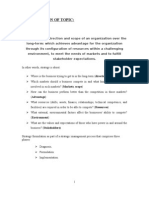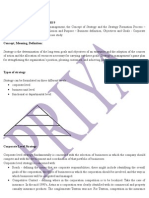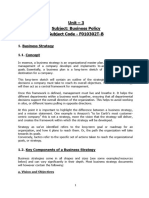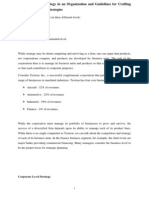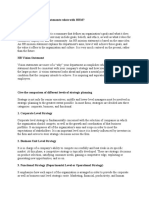Mba Fa Iv Sem 405 Levels of Strategy
Mba Fa Iv Sem 405 Levels of Strategy
Uploaded by
Puja Kumari0 ratings0% found this document useful (0 votes)
39 views10 pagesThe document discusses three levels of strategy: corporate level, business level, and functional level. The corporate level strategy defines the business areas and portfolio of the firm. The business level strategy establishes the competitive position for each business unit. Finally, the functional level strategy sets short-term objectives for departments like marketing and production to achieve the business unit strategies.
Original Description:
Original Title
MBA FA IV SEM 405 LEVELS OF STRATEGY-converted
Copyright
© © All Rights Reserved
Available Formats
PDF, TXT or read online from Scribd
Share this document
Did you find this document useful?
Is this content inappropriate?
The document discusses three levels of strategy: corporate level, business level, and functional level. The corporate level strategy defines the business areas and portfolio of the firm. The business level strategy establishes the competitive position for each business unit. Finally, the functional level strategy sets short-term objectives for departments like marketing and production to achieve the business unit strategies.
Copyright:
© All Rights Reserved
Available Formats
Download as PDF, TXT or read online from Scribd
Download as pdf or txt
0 ratings0% found this document useful (0 votes)
39 views10 pagesMba Fa Iv Sem 405 Levels of Strategy
Mba Fa Iv Sem 405 Levels of Strategy
Uploaded by
Puja KumariThe document discusses three levels of strategy: corporate level, business level, and functional level. The corporate level strategy defines the business areas and portfolio of the firm. The business level strategy establishes the competitive position for each business unit. Finally, the functional level strategy sets short-term objectives for departments like marketing and production to achieve the business unit strategies.
Copyright:
© All Rights Reserved
Available Formats
Download as PDF, TXT or read online from Scribd
Download as pdf or txt
You are on page 1of 10
TOPIC NAME: LEVELS OF STRATEGY
The word “strategy” is derived from the Greek word
“stratçgos”; stratus (meaning army) and “ago”
(meaning leading/moving).
Strategy is an action that managers take to attain one or
more of the organization’s goals. Strategy can also be
defined as “A general direction set for the company and
its various components to achieve a desired state in the
future. Strategy results from the detailed strategic
planning process”.
A strategy is all about integrating organizational activities and utilizing
and allocating the scarce resources within the organizational
environment so as to meet the present objectives. While planning a
strategy it is essential to consider that decisions are not taken in a
vacuum and that any act taken by a firm is likely to be met by a
reaction from those affected, competitors, customers, employees or
suppliers.
Strategy can also be defined as knowledge of the goals, the uncertainty
of events and the need to take into consideration the likely or actual
behavior of others. Strategy is the blueprint of decisions in an
organization that shows its objectives and goals, reduces the key
policies, and plans for achieving these goals, and defines the business
the company is to carry on, the type of economic and human
organization it wants to be, and the contribution it plans to make to its
shareholders, customers and society at large.
Strategy can be formulated at three levels, namely, the corporate level,
the business level, and the functional level. At the corporate level,
strategy is formulated for your organization as a whole. Corporate
strategy deals with decisions related to various business areas in which
the firm operates and competes. At the business unit level, strategy is
formulated to convert the corporate vision into reality. At the functional
level, strategy is formulated to realize the business unit level goals and
objectives using the strengths and capabilities of your organization.
There is a clear hierarchy in levels of strategy, with corporate level
strategy at the top, business level strategy being derived from the
corporate level, and the functional level strategy being formulated out
of the business level strategy.
In a single business scenario, the corporate and business level
responsibilities are clubbed together and undertaken by a single group,
that is, the top management, whereas in a multi business scenario, there
are three fully operative levels.
1. Corporate Level:
Corporate level strategy defines the business areas in which your
firm will operate. It deals with aligning the resource deployments
across a diverse set of business areas, related or unrelated.
Strategy formulation at this level involves integrating and
managing the diverse businesses and realizing synergy at the
corporate level. The top management team is responsible for
formulating the corporate strategy. The corporate strategy reflects
the path toward attaining the vision of your organization. For
example, your firm may have four distinct lines of business
operations, namely, automobiles, steel, tea, and telecom. The
corporate level strategy will outline whether the organization
should compete in or withdraw from each of these lines of
businesses, and in which business unit, investments should be
increased, in line with the vision of your firm.
2. Business Level:
Business level strategies are formulated for specific
strategic business units and relate to a distinct product-
market area. It involves defining the competitive position of
a strategic business unit. The business level strategy
formulation is based upon the generic strategies of overall
cost leadership, differentiation, and focus. For example,
your firm may choose overall cost leadership as a strategy
to be pursued in its steel business, differentiation in its tea
business, and focus in its automobile business. The business
level strategies are decided upon by the heads of strategic
business units and their teams in light of the specific nature
of the industry in which they operate.
3. Functional Level:
Functional level strategies relate to the different functional areas which a
strategic business unit has, such as marketing, production and operations,
finance, and human resources. These strategies are formulated by the
functional heads along with their teams and are aligned with the business level
strategies. The strategies at the functional level involve setting up short-term
functional objectives, the attainment of which will lead to the realization of the
business level strategy.
For example, the marketing strategy for a tea business which is following the
differentiation strategy may translate into launching and selling a wide variety
of tea variants through company-owned retail outlets. This may result in the
distribution objective of opening 25 retail outlets in a city; and producing 15
varieties of tea may be the objective for the production department. The
realization of the functional strategies in the form of quantifiable and
measurable objectives will result in the achievement of business level strategies
as well.
Corporate Level Strategy:
◦ Defines the business areas in which your firm will operate.
◦ Involves integrating and managing the diverse businesses and
realizing synergy at the corporate level.
◦ Top management team is responsible.
Business Level Strategy:
◦ Involves defining the competitive position of a strategic business
unit.
◦ Decided upon by the heads of strategic business units and their
teams.
Functional Level Strategy:
◦ Formulated by the functional heads along with their teams.
◦ Involve setting up short-term functional objectives.
You might also like
- PMP Exam Prep 2023-2024 Covers The Current PMP Exam Content Agile and Predictive Content 2023Document391 pagesPMP Exam Prep 2023-2024 Covers The Current PMP Exam Content Agile and Predictive Content 2023mohamadelsb3Noch keine Bewertungen
- Strategic Management Full Notes PDFDocument135 pagesStrategic Management Full Notes PDFPrasad Naik100% (6)
- Stratgy FormulationDocument19 pagesStratgy FormulationDua Ahmed94% (16)
- CIPD L&D Annual Survey Report 2015Document45 pagesCIPD L&D Annual Survey Report 2015angelfire23phNoch keine Bewertungen
- 3 Levels of StrategyDocument2 pages3 Levels of StrategyQueen Valle100% (2)
- Strategic Management Full NotesDocument135 pagesStrategic Management Full NotesAditya Kumar94% (17)
- Police OrgDocument70 pagesPolice OrgSeagal UmarNoch keine Bewertungen
- Presentation 1Document10 pagesPresentation 1ashish2965610Noch keine Bewertungen
- Organizational StrategyDocument7 pagesOrganizational StrategySREEDEVI T SURESHNoch keine Bewertungen
- The Three Levels of StrategyDocument4 pagesThe Three Levels of StrategyFardeen Leo100% (2)
- Assignment # 3 Difference Between Financial and Strategic ObjectivesDocument5 pagesAssignment # 3 Difference Between Financial and Strategic ObjectivesFaisal AwanNoch keine Bewertungen
- Lecture 4Document5 pagesLecture 4Shuja MirNoch keine Bewertungen
- Answer of Question 5Document3 pagesAnswer of Question 5skxpolNoch keine Bewertungen
- Student Strategic ManagementDocument25 pagesStudent Strategic Managementpradeep100% (1)
- Strategic Management IntroductionDocument8 pagesStrategic Management IntroductionKushagra GautamNoch keine Bewertungen
- Notes On Strategy Strategy PlanningDocument23 pagesNotes On Strategy Strategy PlanningAmrita PatilNoch keine Bewertungen
- Unit1 Strategic ManagementDocument15 pagesUnit1 Strategic Managementpuskarcing16Noch keine Bewertungen
- Strategic Management Unit-I Strategy and Process 9: Corpo Rate Strate GY Business StrategyDocument90 pagesStrategic Management Unit-I Strategy and Process 9: Corpo Rate Strate GY Business StrategySujata SuryawanshiNoch keine Bewertungen
- Strategic MGT FINALDocument136 pagesStrategic MGT FINALAnonymous lZ0hmpoFNoch keine Bewertungen
- Unit 1 SM NOTESDocument17 pagesUnit 1 SM NOTES6038 Mugilan kNoch keine Bewertungen
- Strategic Management Full NotesDocument137 pagesStrategic Management Full NotesAnishaAppuNoch keine Bewertungen
- Strategic Management Full Notes 1Document137 pagesStrategic Management Full Notes 1ArihantAskiGoswami100% (1)
- Strategic Management Full NotesDocument145 pagesStrategic Management Full Notesgoforcs100% (2)
- SM Notes 20MBA25Document136 pagesSM Notes 20MBA25Jamuna SNoch keine Bewertungen
- Strategicmanagementfullnotes 110824114832 Phpapp01Document128 pagesStrategicmanagementfullnotes 110824114832 Phpapp01Amit RaiNoch keine Bewertungen
- Strategic Management Full NotesDocument133 pagesStrategic Management Full Notessahir_sameer1984100% (1)
- Strategic Control, Levels of StrategyDocument8 pagesStrategic Control, Levels of StrategyTedtenor100% (1)
- Strategic ManagementDocument17 pagesStrategic ManagementAkshil NagdaNoch keine Bewertungen
- Corporate Level StrategyDocument47 pagesCorporate Level Strategycuty_phorum2160100% (1)
- Assignment 1 Strategic ManagementDocument8 pagesAssignment 1 Strategic ManagementManjeet YadavNoch keine Bewertungen
- Strategic Management Is The Ongoing Planning, Monitoring, Analysis and Assessment of AllDocument7 pagesStrategic Management Is The Ongoing Planning, Monitoring, Analysis and Assessment of Allmega texNoch keine Bewertungen
- Marketing Strategies and PlansDocument10 pagesMarketing Strategies and PlansMhyr Pielago CambaNoch keine Bewertungen
- Unit 3 - Business PolicyDocument23 pagesUnit 3 - Business PolicysodusfurikNoch keine Bewertungen
- What Is Corporate Strategy?: Download Ebook: How To Write A Strategic PlanDocument11 pagesWhat Is Corporate Strategy?: Download Ebook: How To Write A Strategic PlanRamojifly LinganNoch keine Bewertungen
- Corporate Strategy Unit 3Document22 pagesCorporate Strategy Unit 3Abhishek ChakrabortyNoch keine Bewertungen
- The Difference Between The Three Levels of Strategy in An OrganizationDocument28 pagesThe Difference Between The Three Levels of Strategy in An OrganizationSasmit PatilNoch keine Bewertungen
- Q Ans, Strategic Management, Sample Question With AnswerDocument23 pagesQ Ans, Strategic Management, Sample Question With AnswertrbvmNoch keine Bewertungen
- Three Levels of Strategy in An Organization and Guidelines For Crafting Successful Business StrategiesDocument10 pagesThree Levels of Strategy in An Organization and Guidelines For Crafting Successful Business Strategiesnahu100% (2)
- Strategic ManagementDocument10 pagesStrategic ManagementDilip KushwahaNoch keine Bewertungen
- SM NotesDocument115 pagesSM Notesanjumalik123Noch keine Bewertungen
- Unit 1 Corprate StrategyDocument9 pagesUnit 1 Corprate StrategyŚonú ŚharmâNoch keine Bewertungen
- Stategic Management Unit 1 NGCDocument14 pagesStategic Management Unit 1 NGCBorish LiffinNoch keine Bewertungen
- Types of Strategies in Strategic ManagementDocument5 pagesTypes of Strategies in Strategic Managementsejal SasteNoch keine Bewertungen
- HR MissionDocument4 pagesHR MissionQwec CiahcNoch keine Bewertungen
- Lesson 3 - The Levels and Formulation of Strategy - LECTURE NOTESDocument4 pagesLesson 3 - The Levels and Formulation of Strategy - LECTURE NOTESJames Bradley HuangNoch keine Bewertungen
- SMU BBA Semester 2 Spring 2012 Drive Solved AssignmentsDocument8 pagesSMU BBA Semester 2 Spring 2012 Drive Solved AssignmentsRajdeep KumarNoch keine Bewertungen
- Concept of StrategyDocument80 pagesConcept of StrategyShruti ShreeNoch keine Bewertungen
- Corporate Strategy Unit IIDocument37 pagesCorporate Strategy Unit IIriyababy22635640Noch keine Bewertungen
- Unit 8 Strategic Management What Is Strategy?Document10 pagesUnit 8 Strategic Management What Is Strategy?Nisha SherpaNoch keine Bewertungen
- SM - 1Document56 pagesSM - 1HarshalNoch keine Bewertungen
- Strategy and Strategic ChoiceDocument3 pagesStrategy and Strategic ChoiceDrishtee DevianeeNoch keine Bewertungen
- Pdf&rendition 1Document4 pagesPdf&rendition 1Amrita PatilNoch keine Bewertungen
- A8 UNIT 4 Lecture 8 Strategy FormulationDocument44 pagesA8 UNIT 4 Lecture 8 Strategy FormulationjeresandrakNoch keine Bewertungen
- Assignment 2 Course Code 8511 Course Name Marketing Management Topic Number 9 Topic Name Corporate Strategic PlanningDocument18 pagesAssignment 2 Course Code 8511 Course Name Marketing Management Topic Number 9 Topic Name Corporate Strategic PlanningAbdullah AliNoch keine Bewertungen
- Introduction To Business StrategyDocument4 pagesIntroduction To Business StrategyLohith H LohithNoch keine Bewertungen
- 01 Strategic AnalysisDocument3 pages01 Strategic AnalysisMd.HasanNoch keine Bewertungen
- The Three Levels of Strategy: in This Chapter, You WillDocument13 pagesThe Three Levels of Strategy: in This Chapter, You WillAbigail PeligrinoNoch keine Bewertungen
- Ma Elec Notes CompilationDocument21 pagesMa Elec Notes CompilationniczNoch keine Bewertungen
- Business PolicyDocument20 pagesBusiness Policybiscuit ovhalNoch keine Bewertungen
- StrategyDocument57 pagesStrategyRohit KumarNoch keine Bewertungen
- Strategic Management Unit IDocument20 pagesStrategic Management Unit ICletus PaulNoch keine Bewertungen
- 5 Od IQZ0 Uw LM7 QQ FMCPB ZV UXYCsnn FQT Husujsc PODocument10 pages5 Od IQZ0 Uw LM7 QQ FMCPB ZV UXYCsnn FQT Husujsc POarpitarmishra08Noch keine Bewertungen
- Fundamental of ManagementDocument21 pagesFundamental of Managementhamza ul haqNoch keine Bewertungen
- تاریخ امت مسلمہ 03Document1,135 pagesتاریخ امت مسلمہ 03Muhammad WaseemNoch keine Bewertungen
- Diagram: Hierarchical OrganisationDocument2 pagesDiagram: Hierarchical OrganisationAbdul Rehman AfzalNoch keine Bewertungen
- MOR 555: Designing High-Performance Organizations: Padler@usc - EduDocument18 pagesMOR 555: Designing High-Performance Organizations: Padler@usc - EduRandip SonowalNoch keine Bewertungen
- Curriculum Vitae ExampleDocument4 pagesCurriculum Vitae ExampleFernan LopezNoch keine Bewertungen
- Business Studies 6-12Document35 pagesBusiness Studies 6-12miloo_1100% (3)
- Human Resource Development (HRD)Document8 pagesHuman Resource Development (HRD)abid ullahNoch keine Bewertungen
- Abdulrahman Dhabaan - (OB Final Project)Document49 pagesAbdulrahman Dhabaan - (OB Final Project)Abdulrahman DhabaanNoch keine Bewertungen
- How Does Business AnalyticsDocument17 pagesHow Does Business AnalyticsAnonymous rcjcZlhVWNoch keine Bewertungen
- Industrial PsychologyDocument3 pagesIndustrial Psychologyazkarubab4Noch keine Bewertungen
- ACOM - Lloyd Company Case AnalysisDocument2 pagesACOM - Lloyd Company Case Analysisjme_pescasio0% (1)
- Data ProtectionDocument6 pagesData Protectionritik mehraNoch keine Bewertungen
- Horizon 2025Document56 pagesHorizon 2025Brian GoweroNoch keine Bewertungen
- Learning Journal Unit 7Document5 pagesLearning Journal Unit 7Winnerton Geochi100% (1)
- Human Resources Management Questions and Expected AnswersDocument236 pagesHuman Resources Management Questions and Expected AnswersBlessed Panashe100% (2)
- MF MCQ 3Document16 pagesMF MCQ 3ShubhamNoch keine Bewertungen
- Project File Jaypee PDFDocument58 pagesProject File Jaypee PDFdivya aryaNoch keine Bewertungen
- PMO ReviewerDocument9 pagesPMO Reviewerkenzo34 martNoch keine Bewertungen
- Drug Prevention Strategies and Program in IndonesiaDocument124 pagesDrug Prevention Strategies and Program in IndonesiaAnti NarkobaNoch keine Bewertungen
- Course Work For Business AdministrationDocument31 pagesCourse Work For Business AdministrationTusiime Wa Kachope SamsonNoch keine Bewertungen
- Affect of CRM-SCM Integration in Retail IndustryDocument8 pagesAffect of CRM-SCM Integration in Retail IndustryRajeev ChinnappaNoch keine Bewertungen
- Budgeting Control and Organizational of Pantukan Chess Club Cooperative Main Branch Pantukan, Davao de OroDocument26 pagesBudgeting Control and Organizational of Pantukan Chess Club Cooperative Main Branch Pantukan, Davao de OroThricia Lou Opiala100% (1)
- Syllabus KM & MonpoDocument2 pagesSyllabus KM & MonpoGaneshNoch keine Bewertungen
- RUKHSANA FinalDocument73 pagesRUKHSANA FinalHarmeet SinghNoch keine Bewertungen
- Prelim - Gov. Business EthicsDocument5 pagesPrelim - Gov. Business Ethicsjessa suazoNoch keine Bewertungen
- Assessment 3 MGNT 210 RealDocument4 pagesAssessment 3 MGNT 210 RealDevaky_Dealish_182Noch keine Bewertungen
- PCM 135 Leadership & Human Relations Management: Assignment Cum Test 4Document5 pagesPCM 135 Leadership & Human Relations Management: Assignment Cum Test 4Affan SiddiquiNoch keine Bewertungen



